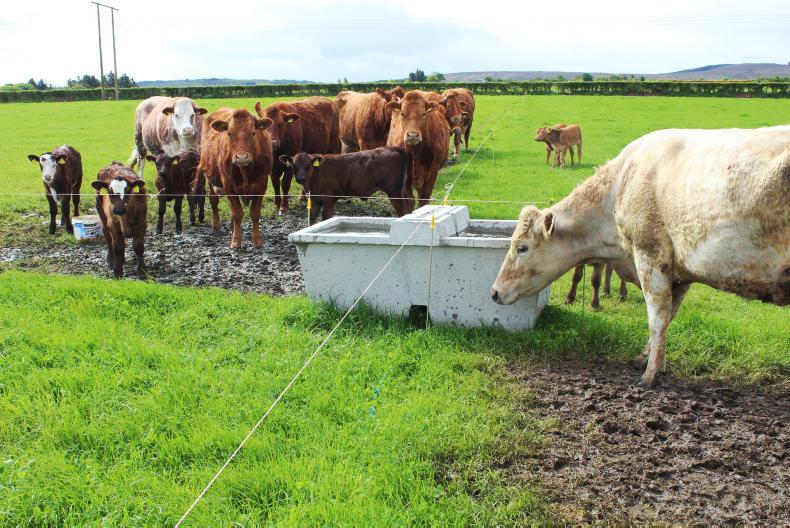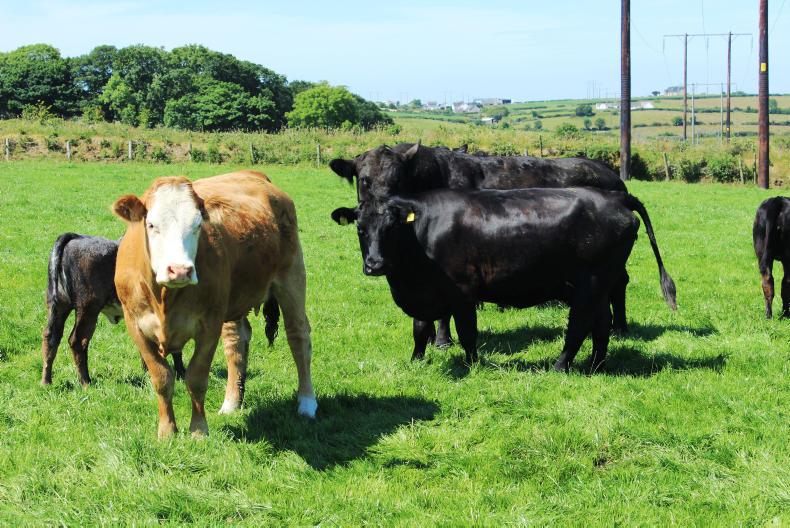The BETTER Farm Beef Challenge NI programme is holding a farm walk on Thursday 30 August on the farm of Jonathan Blair. The event gets under way at 7pm and the evening is open to all members of the public.
Jonathan joined the programme in spring 2017 and, since then, there have been numerous changes to the way that the farm is managed.
The aim of the event is to demonstrate how such changes are being implemented, both big and small.
These include changes to grazing management, fencing, breeding, cattle finishing and animal health.
Farm details
Jonathan runs a spring-calving suckler herd of 65 cows and calves, mostly consisting of Angus, Limousin and Stabiliser genetics.
The farm comprises 262 acres of owned land, with 156 acres in grassland to support the suckler herd and followers.

Rotational grazing is now central to grazing management.
The remaining 106 acres is used for cereal production and contract-rearing dairy heifers, a new development for the farm and geared to maximising farm output.
Some of the key changes to the farming system that will be discussed on the evening are highlighted as follows.
Changing herd genetics
Within the past year, Jonathan has developed a clear breeding strategy for his farm. This will see breeding females gradually moving towards a pure Stabiliser herd of cows over time.
The purpose of this is to breed a consistent cow base with strong maternal traits. Previous stock bulls were mainly terminal sires, leaving cows short on milk.
One reason for this change is that Jonathan likes the idea of using the breed to bring hybrid vigour into his herd from the outset, rather than having to source different breeds to deliver similar results.
Stabiliser genetics also suit intensive bull beef finishing, which is the direction Jonathan wants to move the herd in future, as breeding numbers grow towards his target of 90 cows.
This year, replacement heifers were bred to Stabiliser bulls through AI, with one group of cows served to a Stabiliser bull. The remaining cows were served to an Angus stock bull.
Defined finishing system
As more Stabiliser calves are born into the herd, Jonathan is moving towards finishing male progeny as young bulls under 16 months of age. There will still be some Angus male cattle finished as steers until the herd reaches its target in terms of cow numbers to make the best use of grazed grass.

The herd has been expanding since joining the programme.
Female progeny that are surplus to requirement as breeding replacements are also taken through to slaughter.
Having a tight calving period and a consistent cow type that uses the best available genetics will allow Jonathan to produce more cattle that consistently meet the market specification in terms of carcase weight and conformation.
Calving focus
Herd fertility is good, with a calving index of 362 days for 2018. However, closer analysis shows cows calved over a 12-week period, with 52% of cows calved during the first six weeks of calving.
For a profitable bull-beef system for a spring-calving herd, this is effectively too long.
Efforts are being made to tighten this calving spread into a nine-week period, starting around mid-March.
The target will then be to have around 80% of cows calved inside the first six weeks of the calving period.
The tighter calving period means fewer calves born after mid-May, as these calves are too light to finish at an acceptable carcase weight that will generate a margin to cover finishing costs.
Using AI at grass
Jonathan has been using AI to introduce new genetics into the herd, with replacement heifers normally being inseminated.
Heifers have been synchronised using heat detection aids such as CIDRs in the past, with the Moocall system used in 2018.
Simple paddock fencing options
Paddock grazing is now a key feature on the farm. Paddocks have been split with electric wire using conventional fencers and the Clipex fencing system.
Last year, 1,000m of grazing was fenced using the Clipex system at an approximate cost of £800. The paddocks have greatly improved grass utilisation on farm, with surplus grass now cut for silage.
Soil compaction problems
Jonathan is now reseeding grassland every year. However, silage ground has suffered from severe compaction after harvesting grass during wet conditions in autumn 2017.
Sub-soiling has been used to address this problem and will be a topic for discussion on the evening.
Building the herd for increased profit
As increased profitability is a key aim of the BETTER Farm programme, there will be an overview of the financial performance of the farm over the last two years.
Allied to this will be an insight into the farm’s business plan, which will detail the system currently being implemented to help Jonathan achieve a target gross margin of £1,000/ha.
When Jonathan joined the programme in 2017, the suckler herd consisted of approximately 45 cows.
Expansion
Since then, the herd has expanded by retaining homebred heifers, as well as bringing in maiden heifers to build numbers.
In spring 2018, there were 65 cows and calves on the ground, which will gradually increase towards a target of 90 cows in the next few years.
In 2017, gross margin for the farm was £205/ha and £301/cow. Variable costs, which include purchased feed, fertiliser and grassland costs, veterinary and miscellaneous costs, were £497/ha and accounted for 70% of herd output, which is high.
However, as the herd is in an expansion phase, with heifers retained for breeding rather than finishing, variable costs will naturally be higher as a percentage of output as there are fewer cattle being sold.
As the herd settles around 90 cows and sale numbers increase, output will naturally increase and ultimately increase gross margin.
The BETTER Farm Beef Challenge NI programme is holding a farm walk on Thursday 30 August on the farm of Jonathan Blair. The event gets under way at 7pm and the evening is open to all members of the public.
Jonathan joined the programme in spring 2017 and, since then, there have been numerous changes to the way that the farm is managed.
The aim of the event is to demonstrate how such changes are being implemented, both big and small.
These include changes to grazing management, fencing, breeding, cattle finishing and animal health.
Farm details
Jonathan runs a spring-calving suckler herd of 65 cows and calves, mostly consisting of Angus, Limousin and Stabiliser genetics.
The farm comprises 262 acres of owned land, with 156 acres in grassland to support the suckler herd and followers.

Rotational grazing is now central to grazing management.
The remaining 106 acres is used for cereal production and contract-rearing dairy heifers, a new development for the farm and geared to maximising farm output.
Some of the key changes to the farming system that will be discussed on the evening are highlighted as follows.
Changing herd genetics
Within the past year, Jonathan has developed a clear breeding strategy for his farm. This will see breeding females gradually moving towards a pure Stabiliser herd of cows over time.
The purpose of this is to breed a consistent cow base with strong maternal traits. Previous stock bulls were mainly terminal sires, leaving cows short on milk.
One reason for this change is that Jonathan likes the idea of using the breed to bring hybrid vigour into his herd from the outset, rather than having to source different breeds to deliver similar results.
Stabiliser genetics also suit intensive bull beef finishing, which is the direction Jonathan wants to move the herd in future, as breeding numbers grow towards his target of 90 cows.
This year, replacement heifers were bred to Stabiliser bulls through AI, with one group of cows served to a Stabiliser bull. The remaining cows were served to an Angus stock bull.
Defined finishing system
As more Stabiliser calves are born into the herd, Jonathan is moving towards finishing male progeny as young bulls under 16 months of age. There will still be some Angus male cattle finished as steers until the herd reaches its target in terms of cow numbers to make the best use of grazed grass.

The herd has been expanding since joining the programme.
Female progeny that are surplus to requirement as breeding replacements are also taken through to slaughter.
Having a tight calving period and a consistent cow type that uses the best available genetics will allow Jonathan to produce more cattle that consistently meet the market specification in terms of carcase weight and conformation.
Calving focus
Herd fertility is good, with a calving index of 362 days for 2018. However, closer analysis shows cows calved over a 12-week period, with 52% of cows calved during the first six weeks of calving.
For a profitable bull-beef system for a spring-calving herd, this is effectively too long.
Efforts are being made to tighten this calving spread into a nine-week period, starting around mid-March.
The target will then be to have around 80% of cows calved inside the first six weeks of the calving period.
The tighter calving period means fewer calves born after mid-May, as these calves are too light to finish at an acceptable carcase weight that will generate a margin to cover finishing costs.
Using AI at grass
Jonathan has been using AI to introduce new genetics into the herd, with replacement heifers normally being inseminated.
Heifers have been synchronised using heat detection aids such as CIDRs in the past, with the Moocall system used in 2018.
Simple paddock fencing options
Paddock grazing is now a key feature on the farm. Paddocks have been split with electric wire using conventional fencers and the Clipex fencing system.
Last year, 1,000m of grazing was fenced using the Clipex system at an approximate cost of £800. The paddocks have greatly improved grass utilisation on farm, with surplus grass now cut for silage.
Soil compaction problems
Jonathan is now reseeding grassland every year. However, silage ground has suffered from severe compaction after harvesting grass during wet conditions in autumn 2017.
Sub-soiling has been used to address this problem and will be a topic for discussion on the evening.
Building the herd for increased profit
As increased profitability is a key aim of the BETTER Farm programme, there will be an overview of the financial performance of the farm over the last two years.
Allied to this will be an insight into the farm’s business plan, which will detail the system currently being implemented to help Jonathan achieve a target gross margin of £1,000/ha.
When Jonathan joined the programme in 2017, the suckler herd consisted of approximately 45 cows.
Expansion
Since then, the herd has expanded by retaining homebred heifers, as well as bringing in maiden heifers to build numbers.
In spring 2018, there were 65 cows and calves on the ground, which will gradually increase towards a target of 90 cows in the next few years.
In 2017, gross margin for the farm was £205/ha and £301/cow. Variable costs, which include purchased feed, fertiliser and grassland costs, veterinary and miscellaneous costs, were £497/ha and accounted for 70% of herd output, which is high.
However, as the herd is in an expansion phase, with heifers retained for breeding rather than finishing, variable costs will naturally be higher as a percentage of output as there are fewer cattle being sold.
As the herd settles around 90 cows and sale numbers increase, output will naturally increase and ultimately increase gross margin.








 This is a subscriber-only article
This is a subscriber-only article










SHARING OPTIONS: